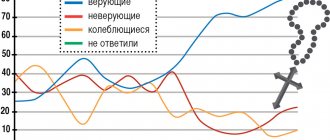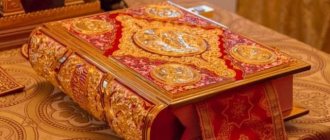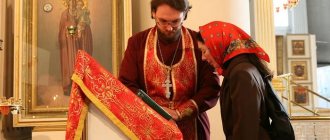Definition and concept of canon law as a system of church legal decrees
Canon law is a system of legal norms of the current church legislation in the Orthodox, Roman Catholic, and Ancient Eastern (pre-Chalcedonian) Churches.
The root word "Canon" is used in Italian, English, French, German and Spanish.
The canonical rules consist of:
- apostolic rules;
- resolutions of the Ecumenical Church Councils;
- resolutions of Local Councils;
- set of rules of the Fathers of the Church.
The Apostolic Rules are the foundation of the church legislation of all Orthodox Local Churches. This is part of the Tradition left by the Apostles themselves.
“Therefore, brethren, stand steadfast and hold fast the traditions which you were taught either by our word or by our message.”
(2 Thess. 2.15)
Canonical rules determine the relationship between clergy and laity.
Recent research by church historians suggests that many decrees from the Apostolic Rules were compiled by the first apostles, and some were added at Ecumenical Councils over time, when the Church emerged from the period of persecution and applied the experience of Roman law.
The system of canon law and its relationship with state laws
Canon law is divided into public and private. The public concerned the provisions and rules of the Roman state. Private refers to the use of individuals.
During the era of the rule of Rome and Byzantium, the interweaving of state and church laws was a logical consequence of the nobility and royal power enlightened in Christianity. Today this historical phenomenon has lost its power.
The Church has no nationality or state affiliation. It is not limited by earthly boundaries, and its universal laws cannot be part of the legislation of a separate state. In Byzantium, subject to “fusion,” it was always possible to separate state and church laws.
Church law does not concern earthly laws of justice.
It concerns conscience and the salvation of the soul. This area does not undergo changes, unlike state law. For believers, church authority has always had greater priority.
The main conflict between church and state is that they have different goals.
Canonical church norms are systematized as follows:
- administrative law (government bodies, types of church authorities, dioceses, parishes);
- composition and organization of the church (laity, clergy, monasticism);
- marriage church law;
- property law;
- relations with Orthodox and non-Orthodox churches;
- relationship with the state.
Ways to form canons, 8 categories of sources of canon law and the basis for its creation
Sources are divided into the following categories:
- divine, or natural, based on Divine Revelation;
- positive, based on legislative church acts;
- written (stated in writing);
- unwritten (kept in the Church as a tradition or custom);
- general - obligatory for the entire Church;
- private - operating in individual Local Churches;
- material persons and institutions (bishops, primates, councils);
- formal (historical documents that set out norms).
There are 7 principles for the creation of church laws and rules, from which canon law is formed.
- Divine right, or Divine Revelation. Contains the fullness of truth as the highest criterion of the legislation of the Church. Contained in the Commandments and the New Testament.
- Church legislation arising from the Church, guided by the Divine will.
- Ecumenical and Local Councils. The infallibility of councils follows from the dogma of the infallibility of the Church. Recognition of the infallibility of the canons does not pose an insurmountable barrier to editing the canon in the event of the loss of the character of the current norm in a changing historical situation.
- Statuary law, or private church legislation. Consists of acts issued by the authorities of Local Churches and bishops. They do not extend beyond the territory of autocephalous Churches and dioceses.
- Pious customs. They can be both church-wide (the bishop must be a monk) and local, not mandatory for use in other regions. Custom is taken into account when considering cases of church courts in the event that in the cases under consideration there is no written law.
- Works and opinions of famous canonists included in legislative church collections.
- State legislative acts concerning the external legal area of the Church, signed by bishops.
When resolving church disputes, there is a rule of hierarchy of legal norms. It lies in the superiority of an act that has a more important status.
The reasons for convening Church Councils are due to emerging disagreements between churches
With the spread of Christ's Teaching throughout the world and the formation of Churches, different liturgical features and legal norms arose in different regions. The need arose to maintain the unity of church teaching.
To investigate misunderstandings, maintain unity and avoid controversial issues, Councils were convened, at which primates and revered elders were present. Council decisions were formalized in the form of messages and sent to dioceses.
One of the main sources of canon law, the first Ecumenical Council. Artist V. I. Surikov, 1876. Painting of the Cathedral of Christ the Savior in Moscow
The teaching of the 12 apostles "Didache" - the first ancient canonical code of church laws
The text of the Didache was finally compiled towards the end of the 1st century AD. It was discovered in 1862 and published in 1883. This scripture sets out postulates on faith and morals, a church disciplinary section, provisions on bishops, clergy and laity, on the Eucharist and attending prayer meetings.
The Didache or Teaching of the 12 Apostles is the oldest document of the apostolic rules.
It also talks about the duties of deacons and deaconesses, the resurrection of the dead, and many other provisions and regulations.
Part of the ancient Didache manuscript - the basis of canon law
This document proves the correctness and truth of the Orthodox faith, which has preserved the apostolic dogmas.
The creation of dogmatic collections is necessary due to the large volumes of church regulations
As a result of the Councils and other canonical sources, many church regulations were formed. To facilitate practical use, collections were compiled, which became sources of general church law.
Collections were divided into 3 types:
- canonical, containing only church rules;
- civil, containing civil acts on church matters;
- mixed, or nomocanons.
The collections are compiled in the chronological sequence of adoption of laws, or by thematic sections.
Classification of sources of canon law according to regional characteristics:
- Greek;
- Byzantine;
- Russian Church.
Church justice
The jurisdiction of the church in relation to its members, and especially in relation to the laity, did not at all flow from Scripture and theological dogmas. Its origin was historical. It was connected, firstly, with the desire of state power to rely on the church in state affairs, and secondly, with the struggle of the church for its own privileges in states.
Back at the end of the 4th century. The law of the Roman emperors Arcadius and Honorius recognized the role of arbiters for Christian bishops in matters concerning the church, or those where the intangible, moral aspects of interhuman relations were affected. Thus, it was intended to make the church a real participant in state court and administration. The affairs of the church and clergy among themselves after the separation of the clergy, as it were, imperceptibly constituted the internal prerogative of the church organization. The Council of Agde (506) expressly prohibited clergy from calling others to secular courts (i.e., filing lawsuits and complaints in them). In 614, the Paris Local Council approved the complete judicial immunity of clergy, prohibiting any secular interference in the affairs of priests. And even in the case of litigation between ecclesiastical and secular authorities, between secular and clergy, the advantage of jurisdiction was on the side of the episcopal court. This was one of the most important class privileges of the clergy.
With the establishment of feudal relations, churches, monasteries, and bishops acquired all the powers of the seigneurial court in relation to vassals, subject populations, and dependent classes. From this source began to arise the increasing power of church courts in relation to the most varied types of cases and various layers of non-clerical persons.
The courts of canon law were based on a more complex judicial procedure than the ordinary feudal courts. The differences became especially evident in the 12th century, when the traditions of Roman law, revised and updated in accordance with new church requirements, became noticeable in canon law. The church was hostile to the basic legal procedures of barbarian times and the feudal court. In 1215, the Fourth Lateran Council prohibited clergy from taking part in judicial trials - ordeals; thus, this usual means of finding “God’s truth” was placed, as it were, outside church law. The church persistently pursued legal battles.
In church affairs, absolute preference was given to a purely written procedure. Both the filing of the complaint and the defendant’s objections had to be in writing. The parties asked each other questions during the hearing on written notes. The court's decision was also recorded. The testimony of witnesses was required to be recorded - under oath and under threat of punishment for perjury. According to the canon law procedure, the parties could have representatives (advocati) who presented legal arguments and provided references to sources of law to assist the litigants.
Strict formalism in judicial procedure was interconnected with a generally new approach of canon law to the meaning of legal proceedings. The court should not have established the rightness of one side and condemned the other, the court should have found out the truth in the case, perhaps even in partial or complete violation of the interests of the one who filed the accusation or complaint. The judge was supposed to interrogate the parties himself according to his own reason and conscience; he was supposed to be internally convinced of the validity and fairness (including from the point of view of canonical dogmas) of his decision in the case. The judge had to find out not only the material circumstances of the case, but also various kinds of motives - sometimes “what the sinner himself, perhaps, does not know or, out of shame, wants to hide.” This, in turn, led the canonical courts to a very harsh attitude towards evidence. Some rules have been developed to distinguish between evidence (irrelevant, unclear or indefinite, evidence of something that creates uncertainty, contrary to nature and therefore useless). Overly formal and strict requirements for the nature of evidence were a difficulty in initiating criminal prosecutions. And the conviction of the original sinfulness of any member of worldly life and his resistance to repentance (one of the foundations of church theological doctrine) pushed canon law and legal proceedings to exaggerate the significance of the accused’s own confession. This significantly restructured the inquisition proceedings.
According to the decision of the IV Lateran Council, the special responsibilities of the church authorities henceforth included the fight against manifestations of various kinds of heresy. Even against those simply suspected of heresy or sympathy for it, if they could not prove their innocence and refute the accusations, persecution should have been initiated. In these conditions, church courts must have a special inquisitorial character, based on the presumption of guilt and sinfulness of the accused. The persecution of heretics was entrusted to the monks of the Dominican and then other orders (1233). For this purpose, special positions of church judges - inquisitors - were established. The inquisitors were soon recognized as beyond the jurisdiction of the ordinary church court, received the right to personally appeal to the pope, and were placed outside any administrative control of the bishops. In 1252, Pope Innocent IV approved the creation of inquisitorial tribunals of 12 judges headed by a bishop. In the investigation and judicial examination of evidence, inquisitors were allowed to use torture. In criminal cases, one’s own confession (especially in matters of accusations of heresy, and if desired, any discrepancies with church rules could be included as such) became the main type of evidence, indicating both the correctness of the court’s conclusions and the repentance of the criminal that cleanses the sinful soul. This permanently distorted legal proceedings in the canonical courts in the case of the most important accusations and prosecutions.
Church judicial procedure also had a significant influence on secular courts in Europe. The overly harsh and peculiar attitude of canon law to procedural evidence became, however, the reason for the spread in justice of unnecessary delays in the analysis of cases, the beginning of the practice of months and many years of litigation.
The canon law of the Roman Catholic Church emerged in the 12th century
Among Catholics, starting from the 12th century, canon law emerged from the theological environment and formed into a legal system and scientific discipline. The monk Gratian carried out work to unify the legal and judicial texts of the church, which resulted in a work called the Decree of Gratian.
Before the emergence of Protestantism, the church was built into the structure of political power, was involved in government and influenced all spheres of private and public life. For this reason, the church often came into conflict with secular authorities.
The politicization of the Western Church led to the Inquisition, indulgences and crusades.
The Catholic Church repented of these acts.
The canonical rules received a consistent division into ecclesiastical and administrative aspects after the beginning of the Reformation. In the XIX - XX centuries. Protestant and Catholic canonists argued that church canons are a set of legal texts, decrees of emperors, monarchs, ecclesiastical decrees of the Popes, and other representations of norms and codes relating to the church.
Currently, Roman Catholics have a “Code of Canon Law” of 1983. It regulates all issues of both external and internal legal relations, and covers all areas of activity of the Catholic Church.
By leaving a comment, you accept the user agreement
Formation of a church organization
The Church in the Middle Ages represented a practically independent, autonomously governed political and spiritual organization. In her activities, she was guided by her own rules, developed for herself on the basis of biblical traditions and Christian tradition, which developed into a special system of canon law. Due to the importance of Christian rules for medieval religious society, canon law imposed its requirements not only on clergy and church people, but also on all believers, including state and political institutions of “Christian states.” This special significance of church rules was based on the doctrine of the exclusive, “single-saving role of the church.” It was developed by the greatest political and spiritual thinker, one of the fathers of the Church of St. Augustine
(IV century). According to this doctrine, which has become the official teaching of the Catholic Western Church, the “earthly city” - the world (the creation of the devil and evil) - is opposed to the “city of God”, or the heavenly state (Civitas Dei). A person stuck in earthly life and sins cannot overcome the temptations and chains of the “earthly state” on the way to the “city of God” without the mediating role of the Church. To fulfill this great mission, the Church was initially endowed not only with the rights of spiritual teaching, but also with coercion, the duty to “eradicate the sinfulness of deeds and thoughts” in believers.
In the first centuries of Christianity, even when it became the official religion of the Roman Empire (both Western and Eastern), the entire organization of the church was reduced to the self-government of spiritual communities. From the 3rd century leaders of spiritual communities and associations of these communities (bishops) became permanent, professional clergy. the clergy began to form
- a set of ministers of the church endowed with special religious and sacred rights. These rights were acquired as a result of sacred rites recognized as sacraments. In turn, they provided the basis for performing divine services themselves and performing rituals and sacraments in relation to the laity. Later, based on the doctrine of self-determination of the Church as a perfect and completely free society, an idea was formed about inequality within its framework: the clergy takes precedence over the laity and forces them to believe.
The main figure of the church organization was the bishop, who headed a district of several communities. The bishop had both religious and judicial power; he also had the right to interpret issues of Scripture and church rituals. In the ancient Christian church, bishops were elected or recognized as such by those who were glorified by divine deeds. In the 5th century in the Eastern Roman Church, larger associations arose - patriarchates and metropolitanates; the latter spread to the West. One of the most honorable and ancient episcopal places was Rome - the seat, according to legend, of St. Petra. From the end of the 4th – beginning of the 5th century. The Roman bishops secured for themselves the right to a special status as the head of the entire church - the pope.
The special role of the pope in the Western Catholic Church stemmed from the recognition of him not simply as the superior of the bishops, but as the vicar of God himself, possessing both secular and ecclesiastical power. Founded in the 8th century. The papal state with its center in Rome (see § 23), the power of the pope acquired a completely state-political character. This power was based on the vast land holdings of the Catholic Church, within which its own feudal-feudal structure developed, where the pope was, as it were, the supreme lord. Since 1059, a strict procedure for electing the next pope (he was elected for life) was established - by a college (conclave) of 70 especially honorary bishops - cardinals (from cardo - a special collar on a robe). To manage church affairs and promote the doctrine, a congregation
(formal organization established in 1560).
In addition, the Papal State had its own administration to manage it. Over time, all management was concentrated in a special suburb of Rome - the Vatican
. By the 15th – 16th centuries. it became the true religious, political and cultural center of the Catholic world. It contained (dating back to the time of the Roman Emperor Constantine) numerous sacred relics of early Christianity. In addition to cardinals and bishops, management of church affairs locally and in other states was entrusted to special papal envoys - nuncios.
Cathedrals have acquired a huge role in the governance of the church.
- congresses of bishops. They resolved issues of religious doctrine, the establishment of sacraments and rituals, and the condemnation of deviations from the faith. Representatives of all Christian churches gathered at the first eight councils (IV–VIII centuries). In the 9th century. The dogmatic and administrative separation of the Eastern (Greek) Church began, which was completed by the middle of the 11th century. From that time on, the Roman Catholic Church united only Western and Central European states. The schism occurred, among other things, due to the non-recognition of the eastern supremacy of the popes. Subsequent councils (since 1123 they became regular) were considered ecumenical only within the framework of the Western Catholic Church. Another difference was that the decrees of the councils were not binding on the pope. Local councils of churches of one particular state also gathered.
Monasteries, which were headed by abbots and enjoyed autonomy in court and administration, were of particular importance in the organization of the Catholic Church. In 529, the monastery founded by the monk Benedict in Italy marked the beginning of a new form of intra-church association - monastic orders
(the first was the Benedictine order, then the Franciscans, Dominicans).
In connection with the beginning of the 11th century. Through the movement of the Crusades, spiritual-knightly orders
- special military-political associations of both a spiritual and secular nature. The order was headed by a master, under whose command was a chapter of order elders. The most famous were the orders of the Templars (destroyed at the beginning of the 14th century by the French kings), the Teutonic (which formed their own state in the Baltic states), the Ioannites, and others. Intra-church associations of the Catholic Church enjoyed self-government. But for all levels of the hierarchy and all institutions of the Western Catholic Church without exception, recognition of the supreme authority of the Pope was indispensable.





